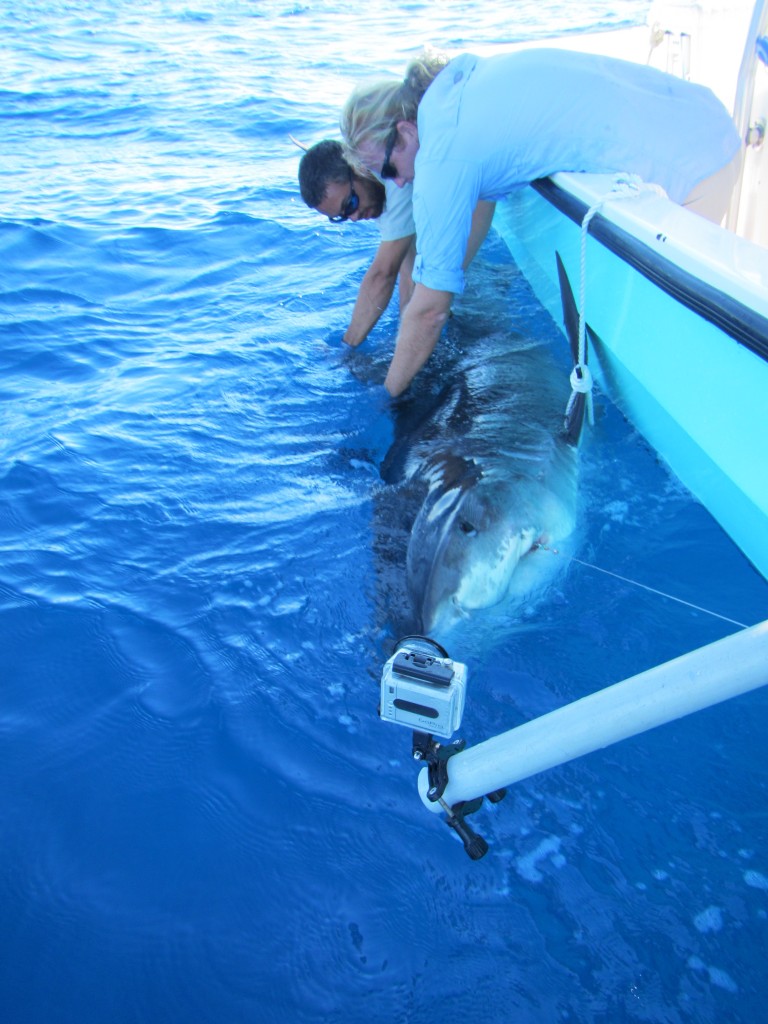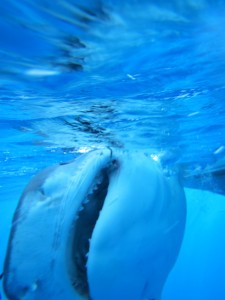The Historic Project shark team has begun to examine and compare the preliminary results from the November 2012 expedition with the previous two expeditions. The data from both November expeditions seems to show similar patterns of a higher Caribbean reef shark species abundance compared to tiger sharks; the two dominate total species captured for this project. This is the opposite of the historic data, as tiger sharks historically had a higher abundance. 
The total catch for November 2011 was 52 sharks over 5 scientific longline sets. The catch per unit effort (CPUE; number of sharks caught per unit of time) from November 2011 was 0.12 Caribbean reef sharks per hour, dominating catch rates at 79% of the total catch. The CPUE for tiger sharks was 0.02 sharks per hour and 17% of the total catch, with the rest of the catch consisting of silky sharks. November 2012 total catch was 36 sharks over 4 research sets. CPUE for Caribbean reef sharks was 0.07 sharks per hour, comprising of 86% of the total catch. The remainder of the catch consisted of tiger sharks, with a CPUE of 0.01 sharks per hour. Due to rough weather the crew was only able to set 4 research lines, resulting in a fewer number of sharks in November 2012 than 2011, although the numbers are still comparable. Interestingly, the March 2012 expedition showed a more equivalent species catch rate. Thirty-two sharks were caught over 6 sets, with Caribbean reef sharks’ CPUE at 0.039 sharks per hour and 47% of the total catch, and tiger sharks’ CPUE at 0.044 sharks per hour and the rest of the total catch. Tiger sharks are a more migratory species in nature, and this data could mean that tiger sharks are moving away from “the bridge” during the fall months and returning in the springtime, shifting the species composition in the area. The historic data set needs to be examined in greater detail for further conclusions about the differences in species abundances and composition, but the preliminary results are beginning to tell an interesting story.
reef sharks per hour, dominating catch rates at 79% of the total catch. The CPUE for tiger sharks was 0.02 sharks per hour and 17% of the total catch, with the rest of the catch consisting of silky sharks. November 2012 total catch was 36 sharks over 4 research sets. CPUE for Caribbean reef sharks was 0.07 sharks per hour, comprising of 86% of the total catch. The remainder of the catch consisted of tiger sharks, with a CPUE of 0.01 sharks per hour. Due to rough weather the crew was only able to set 4 research lines, resulting in a fewer number of sharks in November 2012 than 2011, although the numbers are still comparable. Interestingly, the March 2012 expedition showed a more equivalent species catch rate. Thirty-two sharks were caught over 6 sets, with Caribbean reef sharks’ CPUE at 0.039 sharks per hour and 47% of the total catch, and tiger sharks’ CPUE at 0.044 sharks per hour and the rest of the total catch. Tiger sharks are a more migratory species in nature, and this data could mean that tiger sharks are moving away from “the bridge” during the fall months and returning in the springtime, shifting the species composition in the area. The historic data set needs to be examined in greater detail for further conclusions about the differences in species abundances and composition, but the preliminary results are beginning to tell an interesting story.